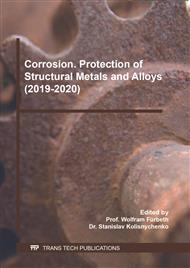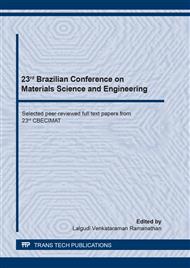p.360
p.366
p.372
p.377
p.385
p.390
p.395
p.401
p.407
Study of the Corrosion of Carbon Steel (SAE 1020) Coated with Niobium Oxides
Abstract:
Carbon steel is widely used in the industry due to its mechanical properties and low cost, but in contrast it resists poorly to corrosion, leading to economic losses and mechanical issues. The use of surface treatment is essential to extend the life of the metallic material. In this context, niobium is being studied for its great corrosion resistance properties. The aim of this paper was to produce and evaluate the corrosion protection of a niobium-based coating produced by the Pechini Method. The resin was applied in the metallic surface by dip-coating and then calcinated at 450 oC for 1 hour. The coated material was analyzed electrochemically by open circuit potential and potentiodynamic polarization, and morphologically by X-ray diffraction, scanning electron microscopy and energy dispersive spectroscopy. The electrochemical analyses showed that the deposition of the coating increased the corrosion resistance and the morphological analyses indicated a homogenous coating with the presence of phases of NbO and NbO2.
Info:
Periodical:
Pages:
385-389
Citation:
Online since:
October 2020
Keywords:
Price:
Сopyright:
© 2020 Trans Tech Publications Ltd. All Rights Reserved
Share:
Citation:



